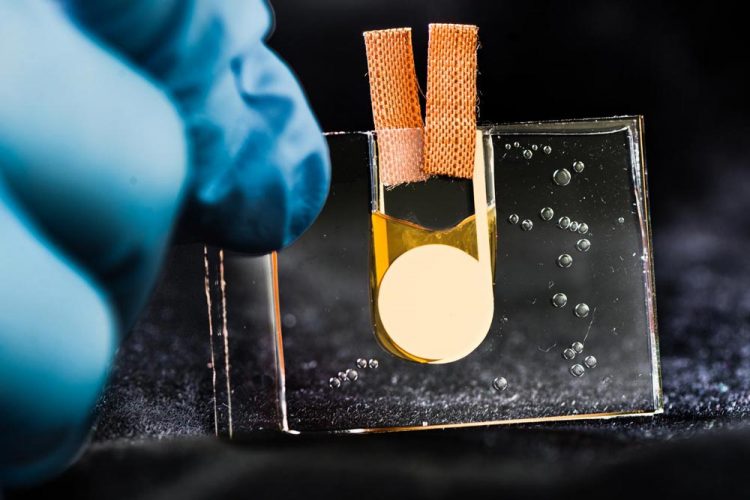The world's first heat-driven transistor

This is the heat driven transistor on Laboratory of organic electronics, Linköping University. Credit: Thor Balkhed
“We are the first in the world to present a logic circuit, in this case a transistor, that is controlled by a heat signal instead of an electrical signal,” states Professor Xavier Crispin of the Laboratory of Organic Electronics, Linköping University.
The heat-driven transistor opens the possibility of many new applications such as detecting small temperature differences, and using functional medical dressings in which the healing process can be monitored.
It is also possible to produce circuits controlled by the heat present in infrared light, for use in heat cameras and other applications. The high sensitivity to heat, 100 times greater than traditional thermoelectric materials, means that a single connector from the heat-sensitive electrolyte, which acts as sensor, to the transistor circuit is sufficient. One sensor can be combined with one transistor to create a “smart pixel”.
A matrix of smart pixels can then be used, for example, instead of the sensors that are currently used to detect infrared radiation in heat cameras. With more developments, the new technology can potentially enable a new heat camera in your mobile phone at a low cost, since the materials required are neither expensive, rare nor hazardous.
The heat-driven transistor builds on research that led to a supercapacitor being produced a year ago, charged by the sun's rays. In the capacitor, heat is converted to electricity, which can then be stored in the capacitor until it is needed.
The researchers at the Laboratory of Organic Electronics had searched among conducting polymers and produced a liquid electrolyte with a 100 times greater ability to convert a temperature gradient to electric voltage than the electrolytes previously used. The liquid electrolyte consists of ions and conducting polymer molecules. The positively charged ions are small and move rapidly, while the negatively charged polymer molecules are large and heavy. When one side is heated, the small ions move rapidly towards the cold side and a voltage difference arises.
“When we had shown that the capacitor worked, we started to look for other applications of the new electrolyte,” says Xavier Crispin.
Dan Zhao, principal research engineer, and Simone Fabiano, senior lecturer, have shown, after many hours in the laboratory, that it is fully possible to build electronic circuits that are controlled by a heat signal.
###
Since 2014 the research has been financed by the Knut and Alice Wallenberg Foundation as part of the “Tail of the sun” project.
The Laboratory of Organic Electronics
The Laboratory of Organic Electronics, Linköping University, is located on Campus Norrköping, and is the birthplace of the world's first organic transistor and the world's first chemical chip, together with several other organic electronic components. Professor Magnus Berggren is head of the laboratory.
The article:
Ionic thermoelectric gating organic transistors, Dan Zhao, Simone Fabiano, Magnus Berggren and Xavier Crispin, Linköping University, Campus Norrköping, Nature Communications 2017. DOI 10.1038/ncomms14214
Related links:
Here heat is stored as electricity, Research News, Linköping University http://liu.
Contact
Professor Xavier Crispin Xavier.crispin@liu.se +46 11 36 34 85
Media Contact
All latest news from the category: Power and Electrical Engineering
This topic covers issues related to energy generation, conversion, transportation and consumption and how the industry is addressing the challenge of energy efficiency in general.
innovations-report provides in-depth and informative reports and articles on subjects ranging from wind energy, fuel cell technology, solar energy, geothermal energy, petroleum, gas, nuclear engineering, alternative energy and energy efficiency to fusion, hydrogen and superconductor technologies.
Newest articles

A ‘language’ for ML models to predict nanopore properties
A large number of 2D materials like graphene can have nanopores – small holes formed by missing atoms through which foreign substances can pass. The properties of these nanopores dictate many…

Clinically validated, wearable ultrasound patch
… for continuous blood pressure monitoring. A team of researchers at the University of California San Diego has developed a new and improved wearable ultrasound patch for continuous and noninvasive…

A new puzzle piece for string theory research
Dr. Ksenia Fedosova from the Cluster of Excellence Mathematics Münster, along with an international research team, has proven a conjecture in string theory that physicists had proposed regarding certain equations….



